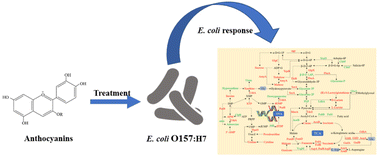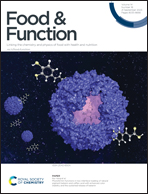A multi-omics analysis strategy reveals the molecular mechanism of the inhibition of Escherichia coli O157:H7 by anthocyanins from Aronia melanocarpa and its application†
Abstract
Water pollution causes the propagation of pathogenic microorganisms, which poses a serious threat to human life. Escherichia coli O157:H7, as a representative organism that can directly exhibit molecular response to stress, was selected as the indicator bacteria for the study. Tandem mass tag (TMT) quantitative proteomics and non-targeted metabolomics were used to study the response of Escherichia coli O157:H7 to Aronia melanocarpa anthocyanin (AMA) treatment. The results showed that 628 proteins and 1338 metabolites changed significantly after treatment with AMAs. According to bioinformatics analysis, integrated proteomics and metabolomics analysis differentially expressed proteins (DEPs) and metabolites participate in pyruvate metabolism, glycolysis/gluconeogenesis, alanine, aspartate and glutamate metabolism and the pentose phosphate pathway. This study preliminarily proposed the inhibition mechanism of AMAs on Escherichia coli O157:H7 from the perspective of multi-omics, providing a theoretical basis for the application of natural preservatives in fresh cut vegetables.



 Please wait while we load your content...
Please wait while we load your content...